|
The
exhibition Legacies
and Visions from Comel to Karshan (fig.
1),
curated by Giulia Martina Weston,
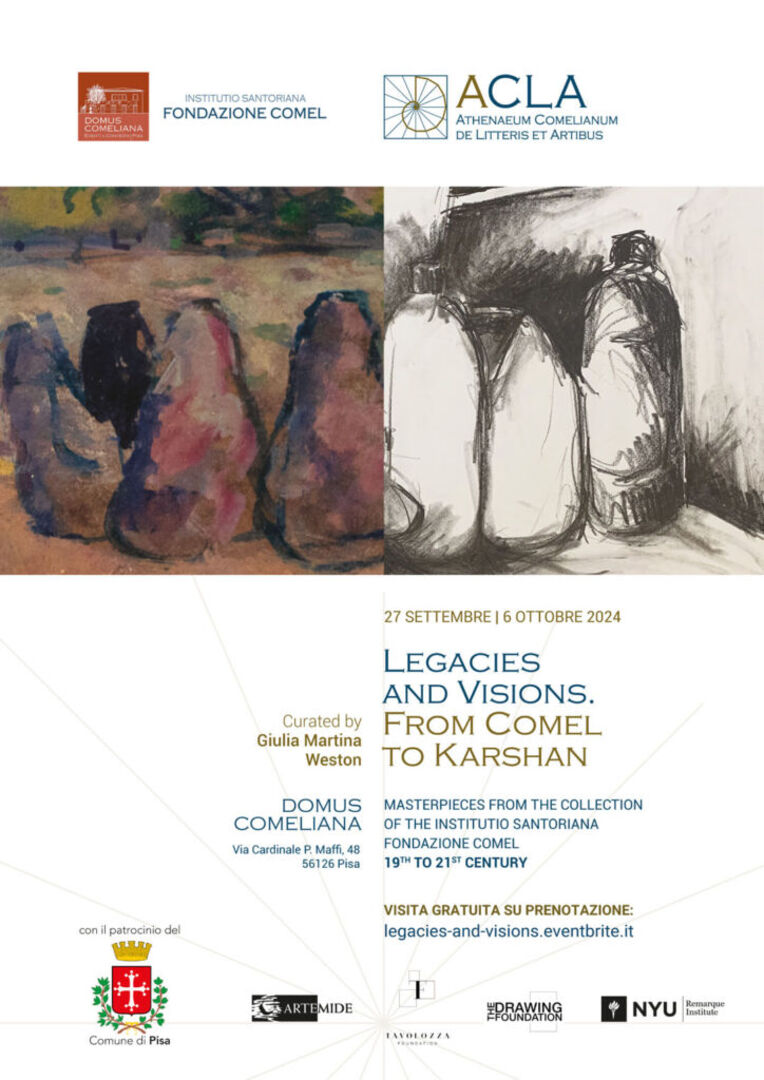 Fig. 1 - Exhibition Poster
Fig. 1 - Exhibition Poster
opened on September 27 th
at the Domus Comeliana in Pisa (via Cardinale Pietro Maffi, 48). It
closed on October 6th,
2024.
By
presenting a selection of paintings, prints, and drawings from the
collection of the illustrious dermatologist and professor Marcello
Comel (Trieste, 1902 – Pisa, 1995), and an anthology of artworks by
Linda Karshan (Minneapolis, 1947), the curator demonstrates that the
taste of the former as well as the art of the latter show a heartfelt
interest in the human body and its dignity. The author of this review
met Linda Karshan during the inauguration of the exhibit. She lives
and works in London and New York and «is
renowned for her seemingly abstract prints and drawings»,
created under the guidance of «her
inner choreography»
.
Her expertise in psychology, philosophy and architectural drawing is
awe-inspiring.
The
curator designed a site-specific exhibit that could help the visitors
understand the vision of Marcello Comel. He built Domus Comeliana
with the aim of facilitating the sharing of knowledge between
scholars from different fields .
Its recent restoration by Carlo Mariani, a virtuoso architect from
Lombardy, has made that place look even more pleasant because it
almost seems to capture and soften the Mediterranean light (fig.
2).
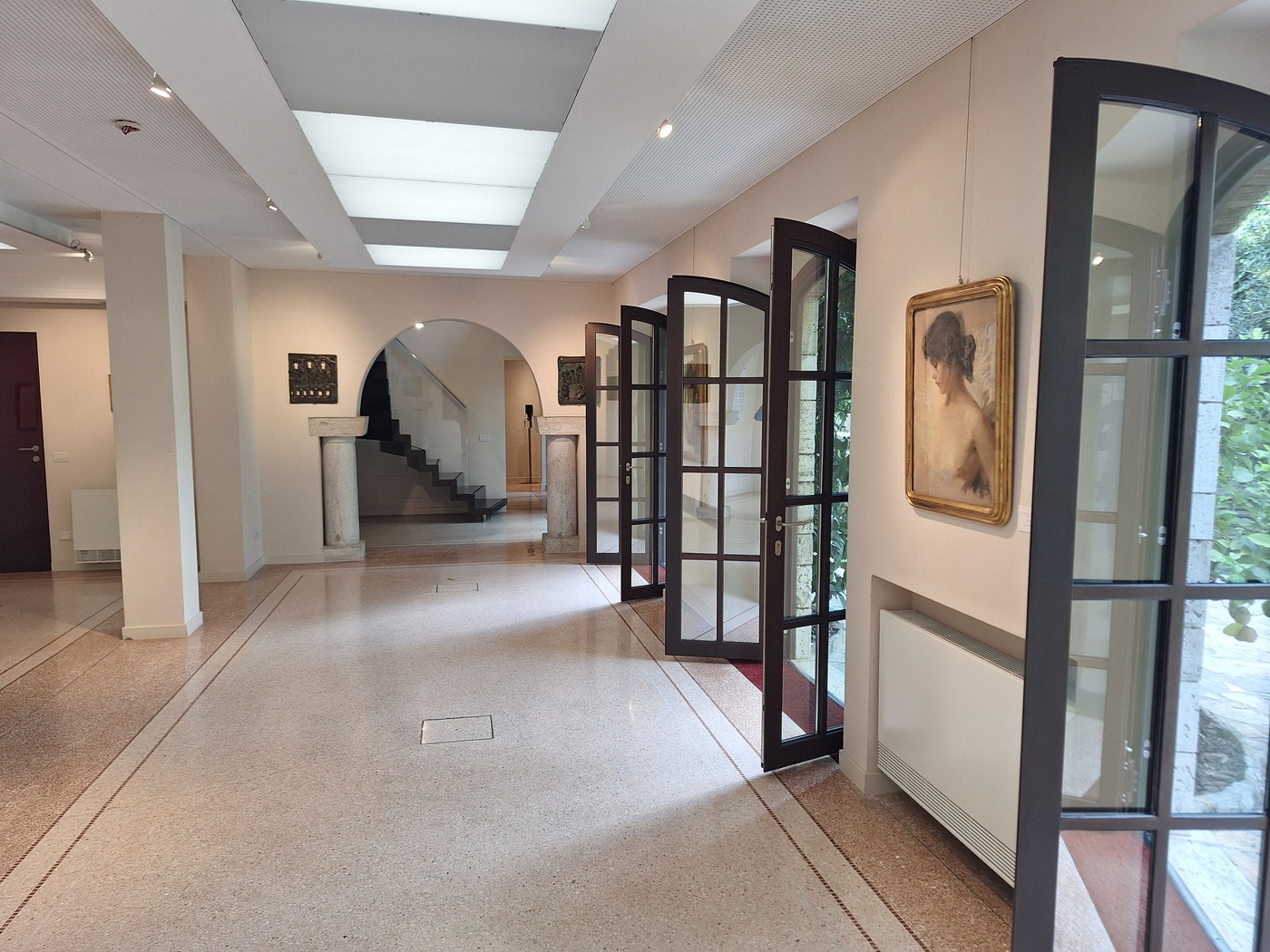 Fig. 2 - Interior of Domus Comeliana
Fig. 2 - Interior of Domus Comeliana
(Cortesy of © Simone Andreoni)
The paintings by Gerolamo Induno, Moses Levy, Arturo Tosi, Lorenzo
Delleani, Giuseppe Pallanti, Carlo Sbisà, and Arturo Nathan, as well
as the drawings and the prints executed by Telemaco Signorini, Mario
Sironi, Filippo De Pisis, and Renato Guttuso provide objective
evidence that the goal of Marcello Comel was genuine. In this
exhibit, the fourteen works executed by Linda Karshan are a further
testament to noble conception of Domus Comeliana: the interaction
between them and the sunlight was surprisingly intense to experience
and transformed the two adjacent rooms in which they are located into
spaces for meditation and even prayer. After all, the creations of
the artist are inspired by Platonism and the transitional space as
described by Donald Winnicott .
Therefore, Legacies
and Visions should
be considered as a curatorial masterpiece.
Such
a statement is not flattery. Weston even managed to devise the
exhibit catalogue as an effective tool to help the visitors
understand her project and the pieces of art that can be seen in the
Domus Comeliana. And it is bilingual. This book
was published by Artemide Edizioni, a publishing house based in Rome
that has worked with prestigious institutions and internationally
renowned scholars. The mastery of Artemide is displayed in the
features of the catalogue: the lettering on the hardcover is blue and
gold: two complementary colours. The pages have smooth surfaces that
are pleasant to touch. The rendering of the photographs is accurate and precisely renders
the tones of the artworks.
The
first thirty-two pages of this catalogue are dedicated to the
explanation of Legacies
and Visions,
its goals and methodology. They introduce the entries on the
forty-two artworks being exhibited. The photographs taken by Tomaso
Maria Pedrotti Dell’Acqua almost seem like a further essay: he has
captured the soulful and the evocative motifs of all the paintings,
drawings, photographs and prints.
The
display of The
Abandoned
(Compassionate
Horse) by
Arturo Nathan (1928)
demonstrates the dexterity of Giulia Martina Weston as a curator and
attests to the objective value of her exhibition (fig.
3)
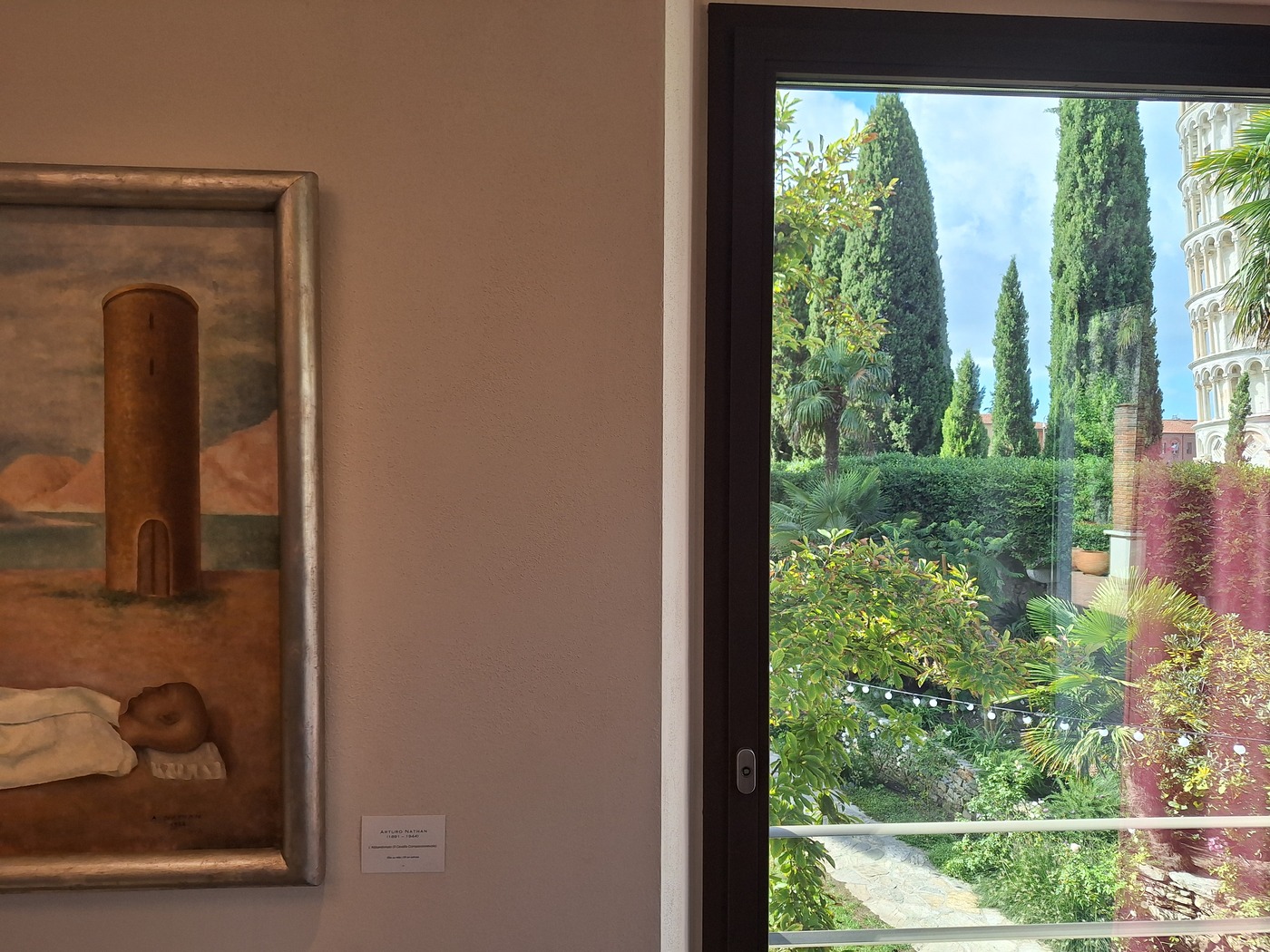 Fig. 3 - Pairing of the tower in
Fig. 3 - Pairing of the tower in
The Abandoned (Compassionate Horse)
by Arturo Nathan and the Torre di Pisa
(Courtesy of © Simone Andreoni)
.
This sombre painting is placed next to the window of the first floor
from which one has the best view of the Torre di Pisa. By pairing it
with the tower in the artwork by Nathan, his role in Italian art
history is now fully acknowledged beyond his fate, also emphasising
the tragic composition of this painting.
Boy
with a Hoop (Camillo Comel) by
Jenny Wiegmann Mucchi (1895-1961)
(fig.
4)
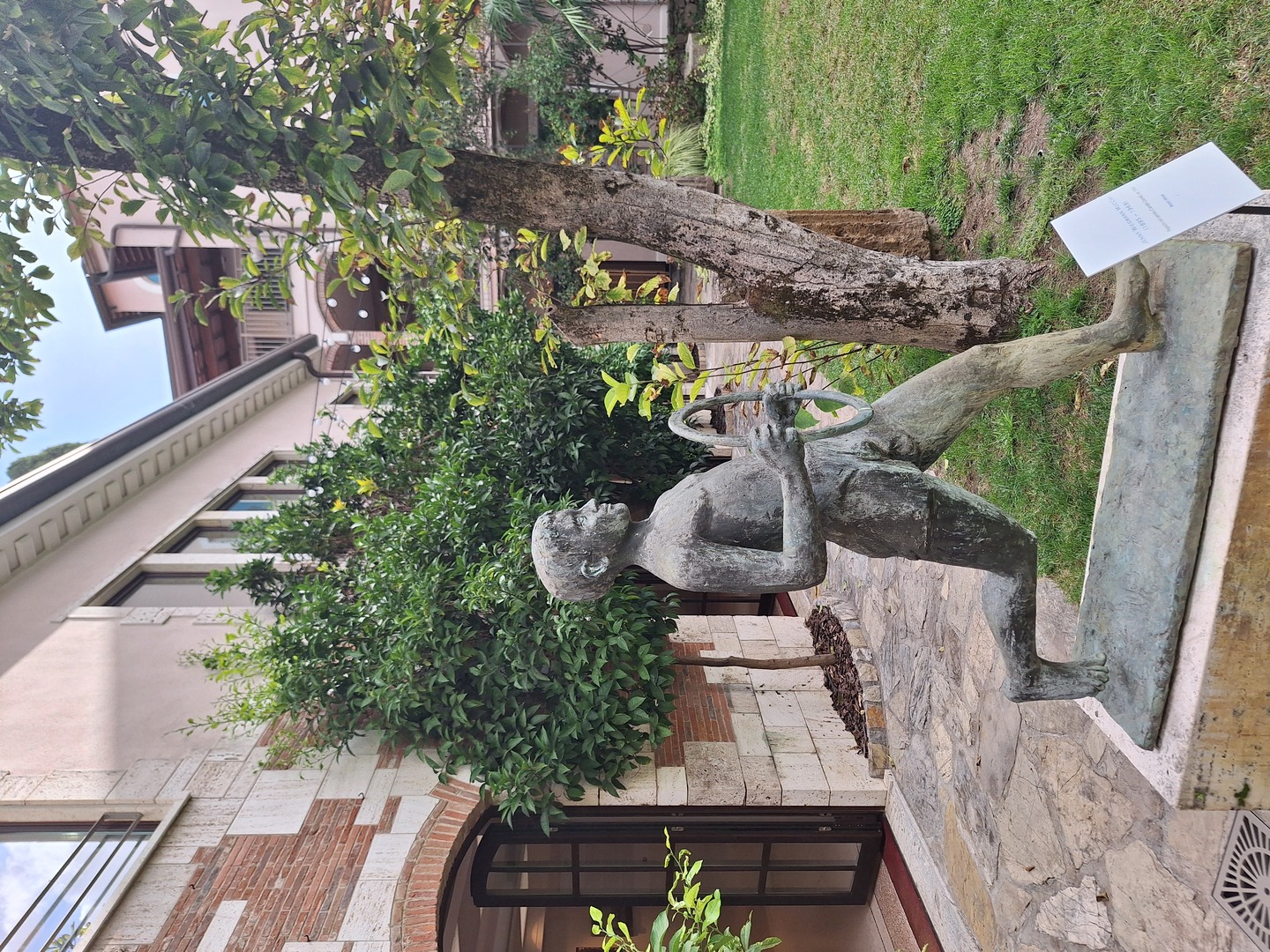 Fig. 4 -JENNY WIEGMANN-MUCCHI
Fig. 4 -JENNY WIEGMANN-MUCCHI
Boy with a Hoop (Camillo Comel)
Pisa, Institutio Santoriana – Fondazione Comel
(Courtesy of © Simone Andreoni)
illustrates
the continuity between the choices of Marcello Comel as a collector
and Linda Karshan's art theory. Wiegmann Mucchi, also
known as Genni, was renowned for her heartfelt anti-fascism and
humanism. Marcello Comel commissioned her to portray his son. In
the exhibition catalogue, Linda Karshan wrote that she was moved by
this artwork: she believes that the artist wanted to convey that
«everything
here is ordered, yet in play»
.
This conception is comparable to
The
Orlo (fig.
5)
and
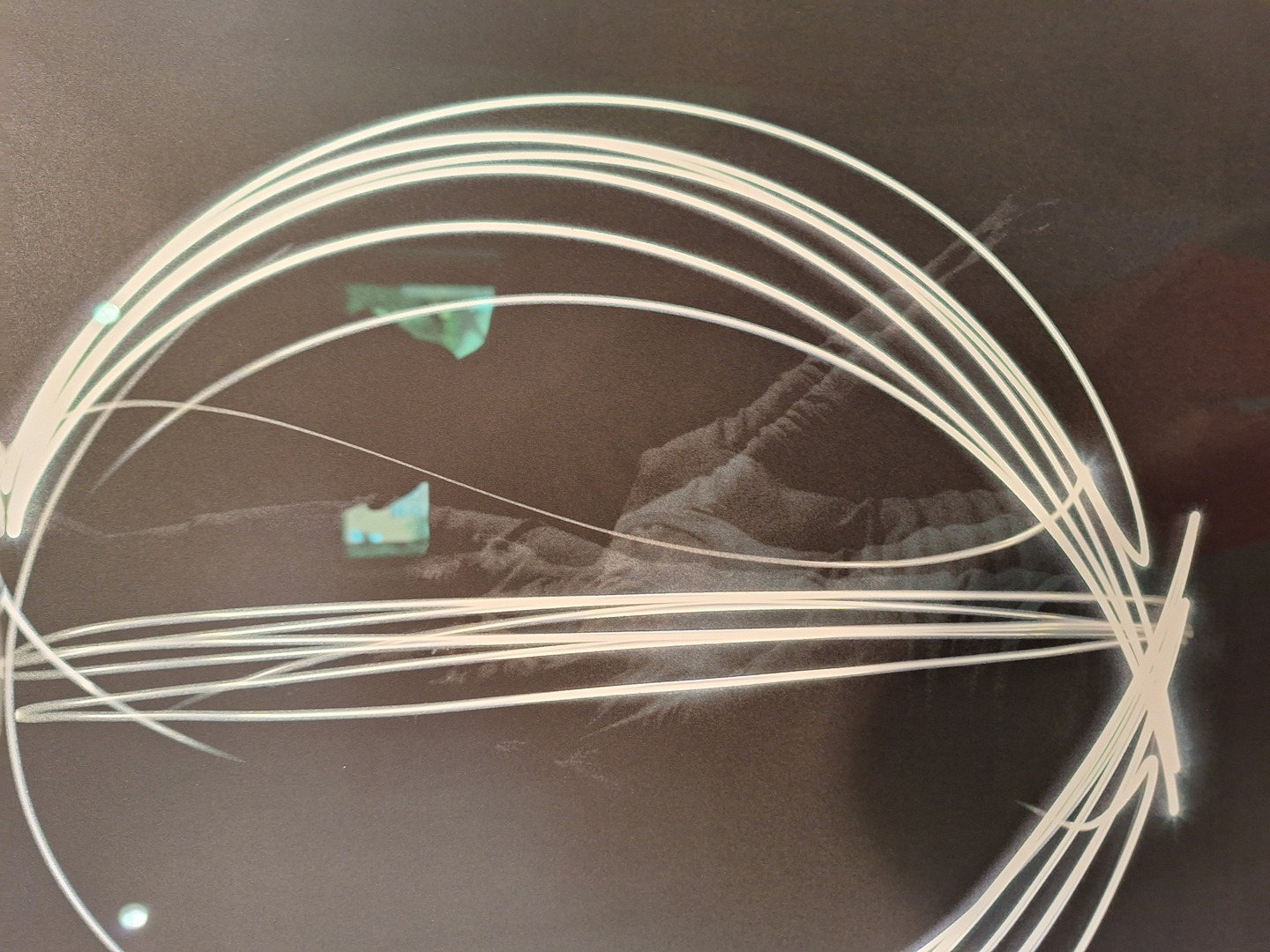 Fig. 5 - TOM FECHT, The Orlo (detail)
Fig. 5 - TOM FECHT, The Orlo (detail)
2004-2009, photographic print on paper, 76 x 56 cm.
Pisa, Institutio Santoriana – Fondazione Comel
(Courtesy of © Simone Andreoni)
The
Orlo Reversed,
photos taken by Tom Fecht between 2004 and 2009 for the project
Karshan
Time .
They depict her drawing with a torch in the empty space of a studio.
Describing
the anthology of the pieces of art created by Linda Karshan is not
easy: she is a cultivated person who truly loves philosophy, art
theory, creating art and psychology. Her personality is impactful,
and her drawing style is almost flaming. She does not create art for
the sake of art, therefore her drawings by no means can be seen
superficially. They demand viewers to inspect and feel
them.
Her performative drawings display both passionate execution and total
control. She truly has mastered how to convey the structure of the
human body with her grids, and how to geometrically compose her
drawings. To such an extent that she can naturally perform both the
tasks. Moreover, her art manifests her solid knowledge of the
language of art materials and their properties and can make the most
out of the white background in her drawings.
Therefore,
Legacies
and Visions is
an unmissable occasion for delving into the visual culture of 19th
and 20th-century
in Italy, rediscovering their value as well as the intrinsic power of
art and its positive effects on the human mind and life.
NOTES
BIBLIOGRAPHY
BUSCEMI
2024
Giulia
BUSCEMI, Tom
Fecht (n. 1952), The Orlo, The Orlo Reversed,
in Legacies
and Visions from Comel to Karshan,
(exhibition catalogue / catalogo della mostra, Pisa, September 27th
– October 6th
/ 27 Settembre – 6 Ottobre 2024), ed. / a cura di G. M. Weston,
Rome / Roma, Artemide Edizioni, 2024, pp. 113-116.
CALABRO
2024
Tommaso
CALABRO, Arturo
Nathan (1891–1944), L’Abbandonato (Il Cavallo Compassionevole),
in
Legacies
and Visions from Comel to Karshan,
(exhibition catalogue / catalogo della mostra, Pisa, September 27th
– October 6th
/ 27 Settembre – 6 Ottobre 2024), ed. / a cura di G. M. Weston,
Rome / Roma, Artemide Edizioni, 2024, pp. 84-87.
FLAMINI
2024
Marzia
FLAMINI, Jenny
Wiegmann Mucchi (1895-1969), Ragazzo col cerchio (Camillo Comel),
in Legacies
and Visions from Comel to Karshan,
(exhibition catalogue / catalogo della mostra, Pisa, September 27th
– October 6th
/ 27 Settembre – 6 Ottobre 2024), ed. / a cura di G. M. Weston,
Rome / Roma, Artemide Edizioni, 2024, pp. 34-36.
KARSHAN
STUDIO 2018 Bio/CV
Linda
KARSHAN STUDIO, Linda
Karshan Bio/CV,
2018, https://static1.squarespace.com/..../Linda+Karshan+Biography+and+CV+2018+WEB.pdf
KARSHAN
STUDIO 2020 Biography
& CV
Linda
KARSHAN STUDIO, Linda
Karshan Biography & CV,
2020, https://lindakarshanstudio.com/bio
.
KARSHAN
2024
Linda
KARSHAN, Eredità,
Filantropia e la Meraviglia dell’Arte / Legacy, Philanthropy and
the Wonder of Art,
in Legacies
and Visions from Comel to Karshan,
(exhibition catalogue / catalogo della mostra, Pisa, September 27th
– October 6th
/ 27 Settembre – 6 Ottobre 2024), ed. / a cura di G. M. Weston,
Rome / Roma, Artemide Edizioni, 2024, pp. 15-18.
WESTON
2024
Giulia
Martina WESTON, Legacies
and Visions. From Comel to Karshan and back / Legacies and Visions.
Da Comel a Karshan e ritorno,
in Legacies
and Visions from Comel to Karshan,
(exhibition catalogue / catalogo della mostra, Pisa, September 27th
– October 6th
/ 27 Settembre – 6 Ottobre 2024), ed. / a cura di G. M. Weston,
Rome / Roma, Artemide Edizioni, 2024, pp. 19-26.
|
